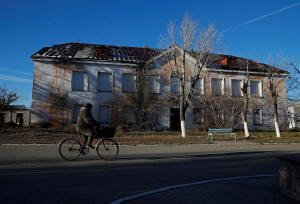'Let us be a lesson', say Kazakhs wary of return to nuclear testing
 Send a link to a friend
Send a link to a friend
 [November 30, 2023]
By Mariya Gordeyeva [November 30, 2023]
By Mariya Gordeyeva
SARYZHAL, Kazakhstan (Reuters) - As Russia warns of the rising risk of
nuclear war, and relations with the United States sink into a deep
freeze, communities close to the vast Soviet-era nuclear testing site in
northern Kazakhstan have a message for leaders: "Let us be a lesson."
Hundreds of tests were carried out between 1949 and 1989 on the barren
steppe near the city of Semey, formerly known as Semipalatinsk, close to
the Kazakh-Russian border. The effect of radiation had a devastating
impact on the environment and local people's health, and continues to
affect lives there today.
Many nuclear proliferation experts believe resuming testing by either
nuclear superpower more than 30 years after the last test is unlikely
soon.
But tensions over Russia's invasion of Ukraine have led to increasingly
hostile rhetoric, and the arms control architecture built since the
Soviet Union's collapse more than three decades ago has begun to
unravel.
In early November, President Vladimir Putin revoked Russia's
ratification of the 1996 global treaty banning nuclear weapons tests.
Moscow says it will not lead to a resumption of testing unless the
United States does first.
"Let our suffering be a lesson to others," said Serikbay Ybyrai, local
leader in the village of Saryzhal, who saw tests being carried out some
20 km (12 miles) away when he was a boy. "If this (testing) resumes,
humanity will disappear."

When devices were detonated above ground - until 1963 when tests went
underground - authorities would order local people out of homes and
schools because of fears that ground tremors might cause buildings to
collapse.
"I remember I was about five years old," said Baglan Gabullin, a
resident of Kaynar, another village that lived under the shadow of
nuclear testing.
He recalled how adults would instruct him and his friends not to look in
the direction of the blast.
"We were small, so on the contrary, out of curiosity we looked. The
flash was yellow at first, and then the black mushroom grew," he said.
Kazakh authorities estimate up to 1.5 million people were exposed to
residual radioactive fallout from testing. Over 1 million received
certificates confirming their status as victims of tests, making them
eligible for an 18,000-tenge ($40) monthly payout.
'EVERYONE STARTED DYING'
Maira Abenova, an activist from the Semey region who set up a
non-governmental organisation protecting the rights of nuclear test
victims after losing most family members to diseases she said were
related, urged politicians not to allow nuclear escalation.
"As someone living with the consequences of what you could call 40 years
of nuclear warfare, I think we can tell the world what we have gone
through," she said.
There is little reliable data on the specific health impact of testing
in Kazakhstan.
But scientists say exposure to radioactive material on the ground,
inhalation of radioactive particles in the air and ingestion of
contaminated food including local livestock contributed to increased
cancer risk and cases of congenital malformation.

[to top of second column]
|

A man rides a bicycle past an abandoned building in the town of
Kurchatov, which housed the command centre of the Semipalatinsk Test
Site, one of the main locations for nuclear testing in the Soviet
Union, in the Abai Region, Kazakhstan November 8, 2023. REUTERS/Pavel
Mikheyev

In Saryzhal, a village of around 2,000 people living in small
white-painted homes surrounded by blue wooden fences, Gulsum
Mukanova recalls how she and other children would watch above-ground
explosions, known as atmospheric tests.
"We were children, everything was interesting to us," she said. "We
would stare at those mushrooms.
"My father died at the age of 58; then my elder brother died, then
my sister," added Mukanova, who is in her mid-60s. "Everyone started
dying."
Gabullin, speaking near a small monument to victims of nuclear tests
erected in Kaynar, also said losses were common.
"There were about 300 tractor drivers who worked with me ... now
only two or three are alive. All died of cancer and leukaemia," he
said. "Even the schoolchildren who worked for me then, now they are
50-53 years old, they are already dying."
Neither he nor Mukanova provided evidence linking disease and
premature deaths to the testing.
While villages such as Kaynar and Saryzhal were exposed to direct
radiation, steppe winds carried nuclear fallout across an area the
size of Italy.
Much of the territory, pockmarked with lakes resulting from blast
craters, is still considered too contaminated to inhabit or
cultivate.
CONTAMINATION LASTS FOR GENERATIONS
About 450 tests were carried out there, more than 100 of them
atmospheric tests and the rest underground. The latter were used
after a 1963 treaty went into force banning nuclear weapons tests in
the atmosphere, in space or underwater, and are considered less
harmful.
After the Soviet Union collapsed in 1991, Moscow no longer had
access to the Kazakh site. Its main equivalent today is in Novaya
Zemlya, an active military site on an Arctic archipelago in Russia's
far north.

Nuclear experts said that any testing today would likely be
underground, which carries environmental and health risks.
"Underground testing can also have severe consequences," said Alicia
Sanders-Zakre of the International Campaign to Abolish Nuclear
Weapons.
"Radioactive particles can vent into the air, and there is also the
potential for contamination of groundwater," she told Reuters,
adding that Russia's position was that it did not intend to test at
this time.
"What's so dangerous about radioactive contamination is that it
lasts for generations."
($1 = 459.0000 tenge)
(Additional reporting by Olzhas Auyezov in Almaty and Gloria Dickie
in London; Writing by Olzhas Auyezov; Editing by Mike Collett-White
and Timothy Heritage)
[© 2023 Thomson Reuters. All rights
reserved.]This material
may not be published, broadcast, rewritten or redistributed.
Thompson Reuters is solely responsible for this content. |